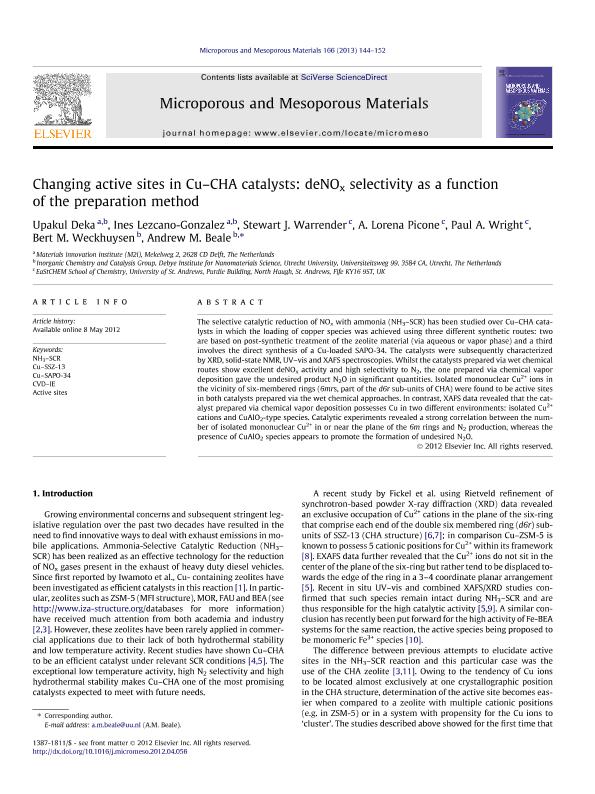Mostrar el registro sencillo del ítem
dc.contributor.author
Deka, Upakul
dc.contributor.author
Lezcano Gonzalez, Ines
dc.contributor.author
Warrender, Stewart J.
dc.contributor.author
Picone, Andrea Lorena

dc.contributor.author
Wright, Paul A.
dc.contributor.author
Weckhuysen, Bert M.
dc.contributor.author
Beale, Andrew M.
dc.date.available
2019-06-07T20:10:20Z
dc.date.issued
2013-01
dc.identifier.citation
Deka, Upakul; Lezcano Gonzalez, Ines; Warrender, Stewart J.; Picone, Andrea Lorena; Wright, Paul A.; et al.; Changing active sites in Cu–CHA catalysts: deNOx selectivity as a function of the preparation method; Elsevier Science; Microporous and Mesoporous Materials; 166; 1-2013; 144-152
dc.identifier.issn
1387-1811
dc.identifier.uri
http://hdl.handle.net/11336/77810
dc.description.abstract
The selective catalytic reduction of NO x with ammonia (NH 3-SCR) has been studied over Cu-CHA catalysts in which the loading of copper species was achieved using three different synthetic routes: two are based on post-synthetic treatment of the zeolite material (via aqueous or vapor phase) and a third involves the direct synthesis of a Cu-loaded SAPO-34. The catalysts were subsequently characterized by XRD, solid-state NMR, UV-vis and XAFS spectroscopies. Whilst the catalysts prepared via wet chemical routes show excellent deNO x activity and high selectivity to N 2, the one prepared via chemical vapor deposition gave the undesired product N 2O in significant quantities. Isolated mononuclear Cu 2+ ions in the vicinity of six-membered rings (6mrs, part of the d6r sub-units of CHA) were found to be active sites in both catalysts prepared via the wet chemical approaches. In contrast, XAFS data revealed that the catalyst prepared via chemical vapor deposition possesses Cu in two different environments: isolated Cu 2+ cations and CuAlO 2-type species. Catalytic experiments revealed a strong correlation between the number of isolated mononuclear Cu 2+ in or near the plane of the 6m rings and N 2 production, whereas the presence of CuAlO 2 species appears to promote the formation of undesired N 2O.
dc.format
application/pdf
dc.language.iso
eng
dc.publisher
Elsevier Science

dc.rights
info:eu-repo/semantics/openAccess
dc.rights.uri
https://creativecommons.org/licenses/by-nc-nd/2.5/ar/
dc.subject
Active Sites
dc.subject
Cu-Sapo-34
dc.subject
Cu-Ssz-13
dc.subject
Cvd-Ie
dc.subject
Nh 3-Scr
dc.subject.classification
Otras Ciencias Químicas

dc.subject.classification
Ciencias Químicas

dc.subject.classification
CIENCIAS NATURALES Y EXACTAS

dc.title
Changing active sites in Cu–CHA catalysts: deNOx selectivity as a function of the preparation method
dc.type
info:eu-repo/semantics/article
dc.type
info:ar-repo/semantics/artículo
dc.type
info:eu-repo/semantics/publishedVersion
dc.date.updated
2019-06-07T14:08:52Z
dc.journal.volume
166
dc.journal.pagination
144-152
dc.journal.pais
Países Bajos

dc.journal.ciudad
Amsterdam
dc.description.fil
Fil: Deka, Upakul. Materials Innovation Institute; Países Bajos. Utrecht University; Países Bajos
dc.description.fil
Fil: Lezcano Gonzalez, Ines. Materials Innovation Institute; Países Bajos. Utrecht University; Países Bajos
dc.description.fil
Fil: Warrender, Stewart J.. University of St. Andrews; Reino Unido
dc.description.fil
Fil: Picone, Andrea Lorena. University of St. Andrews; Reino Unido. Consejo Nacional de Investigaciones Científicas y Técnicas; Argentina
dc.description.fil
Fil: Wright, Paul A.. University of St. Andrews; Reino Unido
dc.description.fil
Fil: Weckhuysen, Bert M.. Utrecht University; Países Bajos
dc.description.fil
Fil: Beale, Andrew M.. Utrecht University; Países Bajos
dc.journal.title
Microporous and Mesoporous Materials

dc.relation.alternativeid
info:eu-repo/semantics/altIdentifier/doi/http://dx.doi.org/10.1016/j.micromeso.2012.04.056
dc.relation.alternativeid
info:eu-repo/semantics/altIdentifier/url/https://www.sciencedirect.com/science/article/pii/S1387181112002831
Archivos asociados
